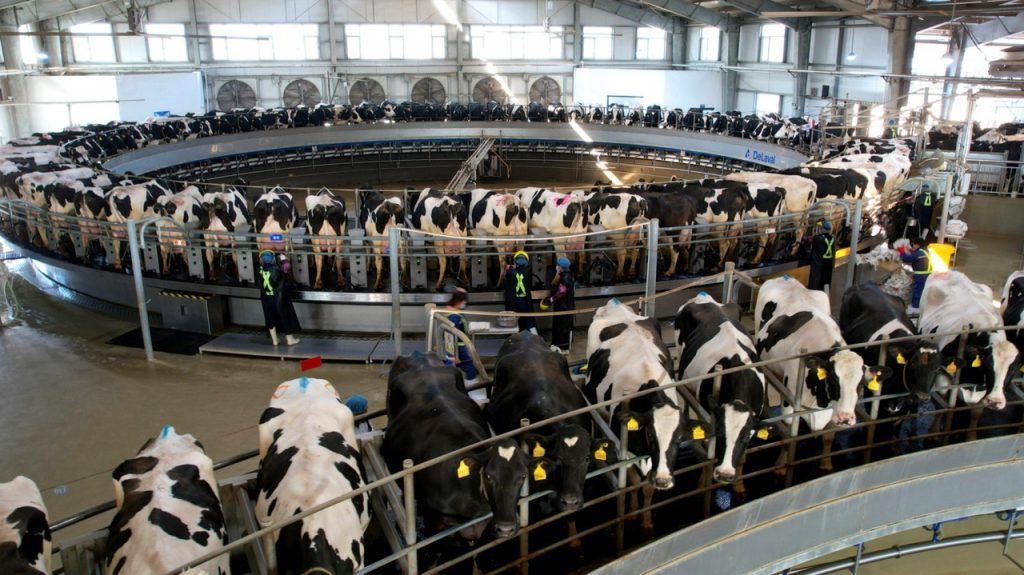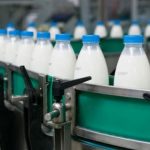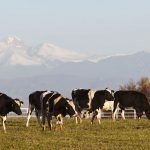
Milk Prices Fall Below Cost, Ranches Selling Cows at Low Prices
On August 17, Tianjin-based rancher Jia Mu posted two notices on social media about “selling cows from the ranch.” One notice was about 100 pregnant dairy cows, six months pregnant, for sale, while the other was about 80 cull cows ready for slaughter. In the video, the pregnant dairy cows and fattened cull cows were seen lying or standing in a pile of hay, wagging their tails, waiting for new owners.
Jia Mu, who has long been involved in the trade of dairy and beef cattle, noticed that since the end of last year, more and more ranchers have approached him to sell their cows.
Following the “plummet in milk prices” in 2023, the continued decline in milk prices and rising costs are still affecting the dairy industry this year. At the lowest point of the fresh milk price this year, rancher Li Li sold milk at 1.2 yuan per kilogram, compared to the high point of 6 yuan per kilogram in 2021. He lamented, “This year, the price of fresh milk is even cheaper than bottled water.”
According to experts, the surplus of fresh milk in 2024 is significantly higher than in 2023, with the profit margin per kilogram of milk for the national dairy industry technology system entering negative territory for the first time. The industry loss rate exceeds 80%.
In response to the current phase of surplus in the raw milk market, some regional authorities and ranchers have started to take measures such as insurance and subsidies to absorb the excess raw milk.
Raw Milk Prices Falling Below Cost
Li Li, head of a dairy cattle breeding company in Hebei, has felt the impact of the raw milk market’s trend this year. His farm, which has 500 dairy cows, has been under significant financial pressure due to the continuous decline in raw milk prices since the second half of last year. In August, the latest batch of fresh milk sold for about 3 yuan per kilogram, and the dairy companies he works with have frequently proposed reducing the amount of milk they collect.
“The excess milk can only be sold at a low price to private milk vendors,” Li Li said. At its lowest, he sold milk at 1.2 yuan per kilogram, noting, “This year, the price of fresh milk is even cheaper than bottled water.”
The persistent drop in raw milk prices has been a common problem for farmers since 2023. On August 13, data from the Ministry of Agriculture and Rural Affairs showed that the average price of fresh milk in 10 major producing provinces, including Inner Mongolia and Hebei, was 3.21 yuan per kilogram, unchanged from the previous week and down 14.6% year-on-year. In October 2021, the weekly price of fresh milk reached a near-high of 4.4 yuan per kilogram, but it has been on a downward trend since September 2023, now at 3.21 yuan per kilogram.
Recently, various regions have held price coordination meetings based on the fresh milk purchasing and selling situation. For instance, on August 16, the Fresh Milk Price Coordination Committee of Inner Mongolia held its third price negotiation meeting for 2024, setting a reference price for the third quarter at 3.25 yuan per kilogram, with an encouragement for quality pricing. Price reductions are capped at 5%. The meeting emphasized that dairy processing companies should continue to sign purchase contracts promptly and ensure full collection.
On August 14, the Ningxia Dairy Industry Association’s third-quarter fresh milk price negotiation set the reference price for the third quarter of 2024 at 3.14 yuan per kilogram, with an allowable increase of up to 4%.
On July 27, the Shaanxi Provincial Animal Husbandry Association Dairy Industry Branch set the third-quarter reference price for fresh milk at not less than 3.05 yuan per kilogram, encouraging quality pricing and ensuring full collection and timely contract renewal by dairy companies. The implementation period is from July 1, 2024, to September 30, 2024.
What does a price drop to around 3 yuan per kilogram mean for ranchers? According to China Dairy Industry magazine, in Shandong, the average feeding cost per kilogram of milk was 3.57 yuan in the second quarter of this year, while the total cost of dairy farming was 3.60 yuan per kilogram. Independent dairy analyst Song Liang noted that with rising costs of raw materials in recent years, the actual cost of dairy farming is between 3 and 3.5 yuan per kilogram, meaning current market prices are below cost, resulting in widespread losses in the industry.
Raw Milk Rejected for Purchase, Leading to Cull Cows
According to the China Dairy Industry Association, the proportion of dairy cows in large-scale farming operations with more than 100 cows increased from 70% in 2021 to 76% in 2023. Many large-scale farms have established fixed cooperation relationships with major dairy companies. Li Li is fortunate to have a fixed contract with a dairy company, which allows him to continue even with reduced milk collection days and lower prices.
A friend of Li Li’s with over 100 cows, who does not have a fixed contract with a dairy company, has had his raw milk repeatedly rejected and has had to sell it at a low price to milk vendors. To reduce costs, he has chosen to cull some of the low-yield cows and sell the rest for beef.
In July, the dairy company Li Li works with suggested controlling the herd size and selling low-yield cows to reduce production capacity. Li Li decided to sell a batch of cows producing less than 25 kilograms of milk per day.
The rapid changes in market conditions have surprised Li Li. He recalls that after the dairy industry bottomed out in 2018, milk prices continued to rise, reaching 6 yuan per kilogram in 2022, and most farmers had an optimistic outlook. With the expansion of farms in recent years, the surplus of milk has become more severe. “How long this downcycle will last is uncertain; we can only adapt to the market,” said Li Li.
Jia Mu, who frequently trades beef cattle in Tianjin, has noticed an increase in ranchers seeking to sell their cows since last year. Both pregnant dairy cows and cull cows are being sold. He explained that due to dairy companies rejecting raw milk, many ranchers are forced to sell or slaughter their cows. The influx of dairy cows into the beef market has also led to a drop in beef prices.
At the 15th China Dairy Conference held in July, Li Shengli, Vice President of the China Dairy Industry Association and Professor at China Agricultural University, reported that the surplus of fresh milk in 2024 is significantly higher than in 2023, with the profit margin per kilogram of milk entering negative territory for the first time. The industry’s loss rate exceeds 80%.
He estimated that a ranch with 1,000 cows would consume 2.4 million yuan in cash flow annually due to a loss of 0.4 yuan per kilogram of milk, with a daily milk yield of 35 kilograms per cow. It is anticipated that during the adjustment period, small calf farms may see a 30% exit rate, and some large farms may undergo restructuring or mergers.
The reasons for the decline in milk prices are multifaceted. A regional agriculture and rural department official in Northwest China explained that the average purchase price of fresh milk began to decline in 2022, marking the return of the dairy industry’s downcycle. Factors such as weak demand for dairy products, rising feed costs, and accelerated expansion of milk supply have contributed to the oversupply and low milk prices.
China food industry analyst Zhu Pengdan also noted that the decline in milk prices is a residual issue from previous years. The Chinese dairy industry experienced rapid growth from 2019 to 2021, and is now in a phase of oversupply, leading to the drop in raw milk prices that began in the third quarter of last year.
Local Subsidies and Insurance Policies to Absorb Excess Capacity
Recently, Li Li has breathed a sigh of relief as the long-rising soybean meal prices have finally begun to decline. Soybean meal is a crucial protein feed in dairy cattle farming. According to data from the Ministry of Agriculture and Rural Affairs, the average price of soybean meal nationwide in June 2024 was 3.70 yuan per kilogram, representing a 1.1% decrease from the previous month and a 14.4% year-on-year drop.
Song Liang analyzed that the dairy product consumption market remains in a low period, and it is expected that the supply-demand relationship in the domestic raw milk market will still be adjusting this year. Whether the market can achieve balance depends largely on the industry’s capacity reduction efforts.
How can lessons be learned to ensure the healthy development of the raw milk market? Song Liang suggested establishing a unified national dairy farming system, implementing a quota system based on regional natural conditions, and creating a mechanism for matching total supply and demand, as well as forecasting and early warning. “Establishing a scientifically coordinated mechanism will reduce occurrences of ‘milk shortages’ and ‘milk surpluses’,” Song Liang said. He also warned that if small and medium-sized farms continue to exit the market, it could lead to a loss of diversification in the domestic dairy industry, increasing future market risks.
Liu Changquan, Director of the Industrial Economics Room at the Institute of Rural Development, Chinese Academy of Social Sciences, also discussed the situation. He noted that in the current phase of raw milk surplus, processing companies generally first focus on stabilizing and protecting their own milk supply capacity. Smaller, more vulnerable farms bear most of the risks.
“Both leading enterprises and relevant government departments should pay timely attention to the survival challenges faced by small and medium-sized farms. In the long term, if domestic consumption demand recovers and there is no growth in imported milk sources, domestic milk production capacity will still be essential. If small and medium-sized farms and other sources exit the market on a large scale, the long-term balance of supply and demand and the overall development of the domestic dairy industry will be severely impacted.”
Red Star News has noted that in response to the current phase of raw milk surplus, some regional authorities and ranchers have begun to take measures, such as insurance and subsidies, to absorb the excess raw milk. In Qingdao, rancher Li Dayong, after reluctantly selling over 50 cows, was able to take advantage of the first insurance cycle for Qingdao’s fresh milk target price insurance, which started at the end of July.
According to Qingdao Daily, the “Notice on Launching the Pilot Program for Fresh Milk Target Price Insurance” issued by Qingdao’s Agricultural and Rural Bureau and the Finance Bureau, among other departments, addresses the issue of continuously declining raw milk purchase prices. Ranchers bear 20% of the insurance premium, while the government subsidizes 80%, with an expected risk guarantee of 350 million yuan for 96,000 tons of fresh milk.
In March this year, Inner Mongolia also issued four subsidy implementation guidelines, such as supporting companies to expand fresh milk processing scale with processing volume subsidies; encouraging processing companies to purchase fresh milk in full during the off-season and provide subsidies for using fresh milk powder; providing subsidies for increased processing of fresh milk into cheese; and offering subsidies to new or expanded projects for producing cheese, whey, and milk proteins. Zhu Pengdan analyzed that encouraging enterprises to engage in deep processing is currently an effective way to address excess capacity.
Many interviewed ranchers, including Li Li, believe there is still significant potential for domestic milk consumption. They hope that dairy companies will produce more affordable milk products, engaging in low-margin, high-volume sales to expand milk consumption and alleviate industry pressure.
You can now read the most important #news on #eDairyNews #Whatsapp channels!!!
🇺🇸 eDairy News INGLÊS: https://whatsapp.com/channel/0029VaKsjzGDTkJyIN6hcP1K




















